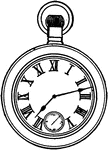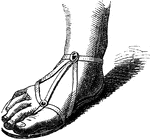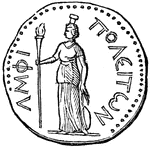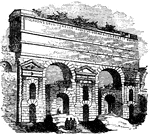
Artemisia Pontica
The common name of Artemisia pontica is Roman wormwood. The plant is shrubby and erect, growing between…

Four O' Clock
Four o' clock and "Marvel of Peru" are the common names of mirabilis jalapa. The flowers grow in clusters…
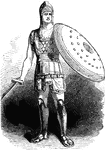
Arms and Armor
The image of a Roman legionnaire. He is equipped with a dense breastplate, a helm, a large round shield,…

Gonfanon
The gonfalon, gonfalone (from the early Italian confalone) is a type of heraldic flag or banner, often…

Gladiators
This illustration shows various types of gladiators, each type with with his specific weapons attributed…
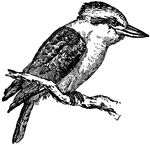
Kingfisher, Dacelo gigas
The Settler's Clock ('Dacelo gigs'), is a very large kingfisher found in Australia, where it receives…
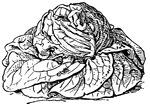
Cabbage Lettuce
Cabbage Lettuce is distinguished by its broad leaves and low spreading habit. It is an annual plant,…

Dieties
A coin engraved with images of Minerva and Jupiter. Minerva was the Roman equivalent to the Greek goddess…

Victory
A representation of Victory, inscribing on a shield the triumph of the Romans; at the same time, she…
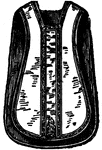
Chasuble
The principle vestment worn by clergy of the Greek and Roman churches during celebration of mass.

Amice
An amice was a loose fitting garment worn by Romans over their tunics; it was also worn by priests and…

Fra Sebastiano
Sebastiano del Piombo (c. 1485 – 1547) was an Italian painter of the High Renaissance and early Mannerist…

Le Puy Cathedral
The Le Puy Cathedral (Cathédrale Notre-Dame du Puy) facade or west front. It is a Roman Catholic cathedral…
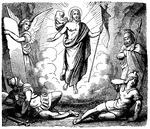
The Resurrection of Jesus after the Angel Removed the Stone from the Tomb Entrance
"And behold, there was a great earthquake; for an angel of the Lord descended from heaven, and came…
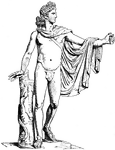
Apollo of the Belvedere - Front View of Statue
Illustration of the famous statue Apollo Belvedere. Created circa AD120-140, the statue depicts Apollo…

A Roman Farmer with a Plow
Illustration of a Roman farmer driving his plow, called an aratrum. The man wears a typical brimmed…

A Roman Standard-Bearer called an Aquilifer
Illustration of an aquilifer carrying the eagle standard for his Roman legion. His left hand sits on…

Gallic Soldier Wearing Trousers and a Horned Helmet
A soldier from Gaul carrying a sword in his right hand and shield in his left. He is wearing a cloak…

Construction Layers of a Section of the Appian Way
Illustration of the various layers of a Roman road. This is a section of the Appian Way, built across…

A Section of Hadrian's Wall in Britain
A small portion of the great, Roman-built Hadrian's Wall in Britain, begun in AD 122. Two men, one sitting…
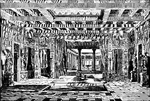
The Interior (Atrium and Peristylium) of Pansa's house at Pompeii, Restored
Illustration of a restored atrium and peristylium of the House of Pansa at Pompeii. The impluvium, pool,…
Pompeiian Stand with Lighted Oil Lamp
A tall, thin lamp stand on a round, ornamented base with three claw feet. The top of the stand has a…
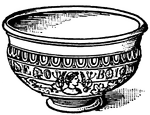
Roman Bowl - Gaulish Samian Ware or Terra Sigillata
Illustration of a Roman bowl found in Pompeii and made by the Gauls. It is an example of what is referred…
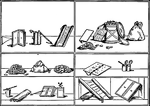
Roman School Materials - Based on a Wall Painting from Pompeii
An illustration of a Pompeiian wall painting of school materials, including scrolls, books, writing…

Roman Toga - View from the Back
A view of the back of a Roman toga. The man stands with his right foot slightly behind his left, as…

Emperor Tiberius Wearing a Toga
Illustration of the Roman Emperor Tiberius wearing a draped toga, which was fashionable in the first…

A Monk with a Pointed Hood and Crosses on His Habit
Illustration of a monk, displaying an open book. His hood is pointed and appears to be unattached from…

Franks Crossing the Rhine to Establish Themselves on the West Bank as Allies of Rome
A group of Franks, mainly men with a couple of women and children, cross the Rhine River on a wooden…
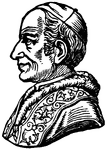
Pope Leo XIII - Side Portrait
Profile of Pop Leo XIII. He was elected pope on February 20th, 1878 and died July 20th, 1903. He was…
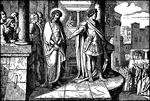
Pilate Brings Jesus Before the People and They Ask for His Crucifixion
"Pilate saith unto them, What then shall I do unto Jesus who is called Christ? They all say, Let him…
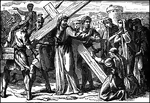
Jesus Carries His Cross and Comforts the Women Following Him
"And there followed him a great multitude of the people, and of women who bewailed and lamented him.…
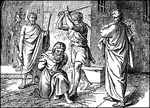
Paul is Beheaded at Rome by the Order of Emperor Nero
Illustration of Paul, kneeling on one knee in the city streets, head bowed, awaiting execution. A man…

Ignatius of Antioch is Martyred by Being Fed to Lions
Illustration of Ignatius of Antioch, also called Ignatius Theophorus, tied to a post by his neck and…

Athanasius is Banished from Alexandria
Illustration of Athanasius, bishop of Alexandria, during one of several times that he was banished from…
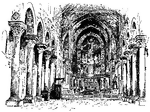
Cathedral of Monreale - Interior View
Illustration of the Cathedral at Monreale, near Palermo. It is an example of Sicilian and Norman architecture.…
![Drawing of the Diana of Versailles, a 2nd-century Roman version in the Greek tradition of iconography. In Roman mythology, Diana ([djana]) was the goddess of the hunt, the moon and childbirth, being associated with wild animals and woodland, and having the power to talk to and control animals.](https://etc.usf.edu/clipart/188200/188203/188203-diana-of-versailles_mth.gif)
Diana of Versailles
Drawing of the Diana of Versailles, a 2nd-century Roman version in the Greek tradition of iconography.…
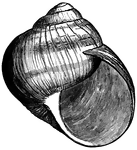
Roman Snail Shell
Helix pomatia. "A large-shelled, edible" snail, also called the Burgundy snail or escargot when used…
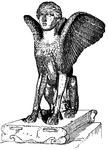
Sphinx of Lanuvium
A Graeco-Roman marble table support in the shape of a sphinx. It was found in the ruins of the Villa…
Spire from the Senlis Cathedral
Illustration of a spire of the Senlis Cathedral in France, early 13th century. It is "one of the earliest…

Jesus Falls While Carrying His Cross
"They took Jesus therefore: and he went out, bearing the cross for himself, unto the place called The…
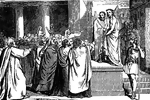
Pilate Brings Jesus Before the People
"Pilate saith unto him, What is truth? And when he had said this, he went out again unto the Jews, and…
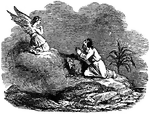
Cornelius the Centurion is Visited by an Angel
"Now there was a certain man in Caesarea, Cornelius by name, a centurion of the band called the Italian…
